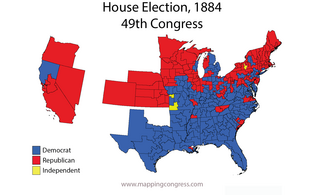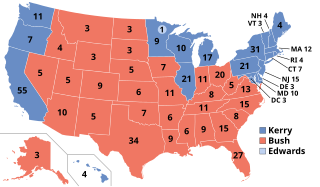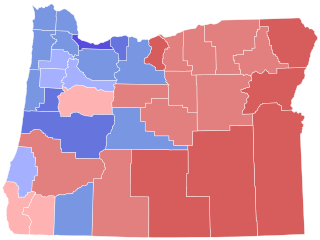
Joseph Lane was an American politician and soldier. He was a state legislator representing Evansville, Indiana, and then served in the Mexican–American War, becoming a general. President James K. Polk appointed Lane as the first Governor of Oregon Territory. When Oregon was admitted as a state in 1859, Lane was elected one of Oregon's first two U.S. Senators.

John Wesley Davis was an American physician and Democratic politician, active in the mid-1800s. He is best known for serving as Speaker of the United States House of Representatives, Governor of the Oregon Territory, and as a four-time member of the Indiana state legislature.

The 1884 United States House of Representatives elections were held for the most part on November 4, 1884, with four states holding theirs early between June and October. They coincided with the election of President Grover Cleveland. Elections were held for 325 seats of the United States House of Representatives, representing 38 states, to serve in the 49th United States Congress. Special elections were also held throughout the year.

The Oregon Republican Party is the state affiliate of the United States Republican Party in Oregon, headquartered in Salem. The party was established in the Oregon Territory in February 1857 as the "Free State Republican Party of Oregon" and held its first state convention on April 1, 1859, after Oregon achieved statehood.

Frank Williamson Benson was an American politician, a Republican, and the 12th Governor of Oregon from 1909 to 1910. A native of California, Benson also served as educator, a land office clerk, and was twice elected as Oregon Secretary of State. From this position he became governor after sitting governor George Earle Chamberlain resigned to become a United States senator.
Like many other U.S. states, the politics of Oregon largely concerns regional issues. Oregon leans Democratic as a state, with both U.S. senators from the Democratic party, as well as five out of Oregon's six U.S. Representatives. The Democratic candidate for president has won in Oregon in every election since 1988. Both houses of Oregon's legislative assembly have been under Democratic control since the 2012 elections.

Joseph Showalter Smith was an American lawyer and politician who served one term as a Representative from the U.S. state of Oregon from 1869 to 1871.

The 2004 United States elections were held on Tuesday, November 2, 2004, during the early years of the war on terror and after the 2003 invasion of Iraq. Republican President George W. Bush won re-election and Republicans retained control of Congress.

Elections in Oregon are all held using a Vote by Mail (VBM) system. This means that all registered voters receive their ballots via postal delivery and can vote from their homes. A state Voters’ Pamphlet is mailed to every household in Oregon about three weeks before each statewide election. It includes information about each measure and candidate in the upcoming election.

The 2012 United States elections took place on November 6, 2012. Democratic President Barack Obama won reelection to a second term and the Democrats gained seats in both chambers of Congress, retaining control of the Senate even though the Republican Party retained control of the House of Representatives. As of 2024, this is the most recent election cycle in which neither the presidency nor a chamber of Congress changed partisan control, and the last time that the party that won the presidency simultaneously gained seats in both the House of Representatives and the Senate.

The 2010 United States House of Representatives elections in Oregon were held on November 2, 2010, to determine who would represent the state of Oregon in the United States House of Representatives. Oregon has five seats in the House, apportioned according to the 2000 United States census. All five incumbents, four Democrats and one Republican, were re-elected to another term. Representatives were elected for two-year terms to serve in the 112th Congress from January 3, 2011, until January 3, 2013; however, re-elected Congressman David Wu resigned partway through his term on August 3, 2011, and a special election was held to fill the rest of his unexpired term.

The 1996 United States elections were held on November 5, 1996. Democratic President Bill Clinton won re-election, while the Republicans maintained their majorities in both houses of the United States Congress.

The 1876 United States elections were held on November 7. In one of the most disputed presidential elections in American history, Republican Governor Rutherford B. Hayes of Ohio ended up winning despite Democratic Governor Samuel J. Tilden of New York earning a majority of the popular vote. The Republicans maintained their Senate majority and cut into the Democratic majority in the House.

Cliff Stewart Bentz is an American lawyer, rancher, and politician serving as the U.S. representative for Oregon's 2nd congressional district. A member of the Republican Party, he is the ranking member on the House Natural Resources Committee Subcommittee on Water, Oceans and Wildlife and sits on the House Judiciary Committee. He previously served in the Oregon Senate, representing the 30th district in Eastern Oregon. He also served in the Oregon House of Representatives, representing the 60th district, which encompasses Malheur, Baker, Harney, and Grant counties, and part of Lake County, and includes the cities of Baker City, Burns, and Ontario. Following the departure of Lori Chavez-DeRemer in 2025, Bentz is the sole Republican in Oregon's congressional delegation.

The 2012 United States House of Representatives elections in Oregon were held on Tuesday, November 6, 2012, to elect the five U.S. representatives from the state of Oregon, apportioned according to the 2010 United States census. The elections coincided with the elections of other federal and state offices, including a quadrennial presidential election. All five incumbents, four Democrats and one Republican, were re-elected to another term.

The 2014 United States Senate election in Oregon took place on November 4, 2014, to elect a member of the United States Senate to represent the State of Oregon, concurrently with the election of the Governor of Oregon, as well as other elections to the United States Senate in other states and elections to the United States House of Representatives and various state and local elections.

The 2014 United States House of Representatives elections in Oregon were held on Tuesday, November 4, 2014, to elect the five U.S. representatives from the state of Oregon, one from each of the state's five congressional districts. The elections coincided with the elections of other federal and state offices, including the governor of Oregon and a United States senator. Primary elections were held on May 20, 2014.

The 2022 Oregon gubernatorial election took place on November 8, 2022, to elect the governor of Oregon. Incumbent Kate Brown took office when fellow Democrat John Kitzhaber resigned on February 18, 2015. She won the subsequent 2016 special election a full term in 2018. Due to term limits, she was unable to run again in 2022.

The 2022 United States House of Representatives elections in Oregon were held on November 8, 2022, to elect the six U.S. representatives from the state of Oregon, one from each of the state's six congressional districts. Primaries for these seats were held on May 17, 2022. The elections coincided with the elections and primaries of other federal and state offices.
This local electoral calendar for 2022 lists the subnational elections held in 2022. Referendums, recall and retention elections, and national by-elections are also included.




















